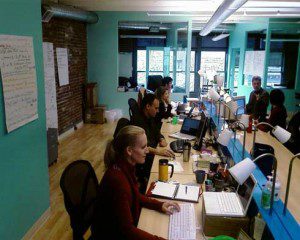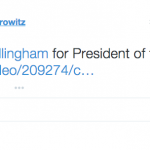Everyone’s a reporter
Three years and 10 million dollars later, has so-called citizen journalism site NowPublic.com democratized the news gathering process? Not exactly...

The NowPublic office in Vancouver
(Photo by: Michael Tippett)
After receiving a US $10.6 million windfall of venture capital financing in July 2007, NowPublic.com co-founder and CEO Leonard Brody boldly promised that in 18 months the participatory news site would be “by reach, the largest news agency in the world.” The small Vancouver start-up that began as an experiment in co-founder Michael Tippett’s garage, Brody continued, was “changing the news business.”Now, nearly halfway through Brody’s time frame for world domination, NowPublic has an estimated 100,000-plus contributing members in nearly 5,000 cities and is growing steadily. About a year before receiving the grant, it had about 13,000 members.
NowPublic was launched in 2005 by three web entrepreneurs: Tippett, Brody and Michael Meyers. The idea for the site grew out of Tippett wondering how the proliferation of wireless technology, camera phones and blogging was going to change the way news was put together and then consumed. The three partners recognized that there would be a need in the market to collect, organize and distribute the vast amount of online content. They also wanted to challenge the traditional idea of top-down editorial decision-making by letting contributors dictate content”. We want to try to reinvent the supply chain of news,” says Tippett. “We want to provide people with a mechanism for participating in the making of news.”
However, NowPublic has been criticized for the type of news it is providing. Rather than offering in-depth coverage, most posts either feature reprinted articles from mainstream media sites or member editorials. But content is almost beside the point. NowPublic isn’t poised to replace traditional news outlets; rather, it represents an evolution in news gathering that is becoming one more weapon in the mainstream media’s arsenal.
NowPublic has since moved out of Tippett’s garage and into a downtown Vancouver headquarters that has a staff of 20 (10 more employees are scattered throughout North America and Europe). Most of the venture capital funding goes towards paying staff. About a third of the NowPublic employees are there to provide editorial guidance to contributors. Providing it is legal, members can post anything and everything on the site, and there is no formal editing process. However, the editorial staff does highlight the good stories, make suggestions for improvement and flag the fishy posts. “It’s very rare that the bad stuff floats to the top,” says Rachel Nixon, NowPublic’s recently appointed global news director. “It’s a more democratic approach to news.” The site’s staff members aren’t the only ones who are able to flag stories. The site also has a fluctuating roster of “guest editors”—active volunteers who are given a certain degree of editorial control. As the global news director, Nixon focuses on increasing the number of editors and contributors around the world.
Active members who post content are crucial to the site’s survival. Without its army of citizen reporters, it is unlikely that the Associated Press (AP) would have been interested in the site. NowPublic currently has a deal with AP that allows the wire service to distribute any of the site’s photos and videos (subject to the approval of the contributor). “We can provide them with the kind of content they wouldn’t be able to get on their own,” says Tippett. AP gets access to the material submitted by thousands of users and in exchange they pay a fee to the contributors whose media they use. NowPublic plans to take a cut of the fee, but has yet to decide how much. So far, AP has used some of NowPublic’s photos on the wire, but in the words of Tippett, “it doesn’t happen everyday.” The company is also experimenting with a text messaging system which would allow them to mobilize contributors in the area of any major news event.
“In a sense with the AP deal, NowPublic is more like a business-to-business commercial model,” says Alfred Hermida, former news editor for BBC News website and current assistant professor of journalism at University of British Columbia. (Full disclosure: Hermida is engaged to Nixon). “What they’re saying is, ‘We can offer value to established media because we can do things they can’t. We can provide them with material they need but don’t have the time, resources or money to invest in developing this kind of operation.’” NowPublic can fulfill the role of a news gathering organization if it manages to keep its numbers up.
Hermida refers to the 90-9-1 rule: 90 per cent of people on the web come to just look, nine per cent occasionally contribute and only one per cent are active members. “Most people tend to be passive,” says Hermida. “The really hard part is building that community of regular contributors.” That’s what NowPublic strives to do. A third of their staff is committed to development—building up the amount of members. So what motivates members to post on NowPublic? “People do it because they want their voice heard,” says Tippett. “They want people to hear what they’re saying.”
Dave Semeniuk, a chemical oceanography grad student at UBC, contributes frequently to NowPublic under the moniker “Science Dave.” He became involved with the site in May 2007 after hearing about it through a date’s roommate. “I got involved as a favour to a friend,” says Semeniuk. “I hadn’t really given thought to the online journalism thing, but I was interested in popular science writing.” For Semeniuk, NowPublic provides an opportunity to improve his writing and get feedback on his stories. NowPublic even covered the fee for him to attend a science journalism conference at UBC.
“The question that keeps coming up with people I tell about NowPublic is motivation: why should someone want to do something for free?” asks Semeniuk. “With the amount of time you put into articles, if you want to do a good job, you shouldn’t want to do it. After maybe five or six months of posting, I stopped putting as much into them because I just didn’t have time.” Although he is one of NowPublic’s guest editors, Semeniuk gets his news elsewhere. “When I first started and got into the citizen journalism mind frame, I thought NowPublic would replace traditional news. I truly believed that anyone could write and anyone could talk about what they knew. That’s not true.”
But wiping out the mainstream media isn’t NowPublic’s goal. “It’s making traditional news outlets aware that theirs isn’t the only perspective on the news,” says Nixon. “It’s about challenging mainstream outlets to integrate citizen journalism into their own content.” Tippett sees NowPublic as complementary to mainstream media. “I think in the end we’ll be partnered with traditional news outlets,” says Tippett. “We think that everyone has something to say and we want to keep the doors as wide open as we can.”
Carla Wintersgill was the Editor for the Spring 2008 issue of the Ryerson Review of Journalism.









































